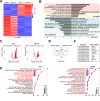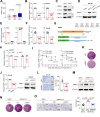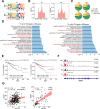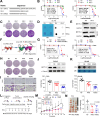Stabilization of RRBP1 mRNA via an m6A-dependent manner in prostate cancer constitutes a therapeutic vulnerability amenable to small-peptide inhibition of METTL3
- PMID: 39367907
- PMCID: PMC11455910
- DOI: 10.1007/s00018-024-05418-6
Stabilization of RRBP1 mRNA via an m6A-dependent manner in prostate cancer constitutes a therapeutic vulnerability amenable to small-peptide inhibition of METTL3
Abstract
Mounting evidence has implicated the RNA m6A methylation catalyzed by METTL3 in a wide range of physiological and pathological processes, including tumorigenesis. The detailed m6A landscape and molecular mechanism of METTL3 in prostate cancer (PCa) remains ill-defined. We find that METTL3 is overexpressed in PCa and correlates with worse patient survival. Functional studies establish METTL3 as an oncoprotein dependent on its m6A enzymatic activity in both AR+ and AR- PCa cells. To dissect the regulatory network of m6A pathway in PCa, we map the m6A landscape in clinical tumor samples using m6A-seq and identify genome-wide METTL3-binding transcripts via RIP-seq. Mechanistically, we discover RRBP1 as a direct METTL3 target in which METTL3 stabilizes RRBP1 mRNA in an m6A-dependent manner. RRBP1 positively correlates with METTL3 expression in PCa cohorts and exerts an oncogenic role in aggressive PCa cells. Leveraging the 3D structural protein-protein interaction between METTL3 and METTL14, we successfully develop two potential METTL3 peptide inhibitors (RM3 and RSM3) that effectively suppress cancer cell proliferation in vitro and tumor growth in vivo. Collectively, our study reveals a novel METTL3/m6A/RRBP1 axis in enhancing aggressive traits of PCa, which can be therapeutically targeted by small-peptide METTL3 antagonists.
Keywords: METTL3; Peptide inhibitor; Prostate cancer; RRBP1; m6A.
© 2024. The Author(s).
Conflict of interest statement
We declare no competing interests.
Figures







Similar articles
-
YTHDF2 mediates the mRNA degradation of the tumor suppressors to induce AKT phosphorylation in N6-methyladenosine-dependent way in prostate cancer.Mol Cancer. 2020 Oct 29;19(1):152. doi: 10.1186/s12943-020-01267-6. Mol Cancer. 2020. PMID: 33121495 Free PMC article.
-
Silencing of METTL3 effectively hinders invasion and metastasis of prostate cancer cells.Theranostics. 2021 Jun 11;11(16):7640-7657. doi: 10.7150/thno.61178. eCollection 2021. Theranostics. 2021. PMID: 34335955 Free PMC article.
-
METTL3 facilitates prostate cancer progression via inducing HOXC6 m6A modification and stabilizing its expression through IGF2BP2-dependent mechanisms.Mol Cell Biochem. 2024 Jul;479(7):1707-1720. doi: 10.1007/s11010-024-05023-y. Epub 2024 May 31. Mol Cell Biochem. 2024. PMID: 38822192
-
Roles of METTL3 in cancer: mechanisms and therapeutic targeting.J Hematol Oncol. 2020 Aug 27;13(1):117. doi: 10.1186/s13045-020-00951-w. J Hematol Oncol. 2020. PMID: 32854717 Free PMC article. Review.
-
The role of the methyltransferase METTL3 in prostate cancer: a potential therapeutic target.BMC Cancer. 2024 Jan 2;24(1):8. doi: 10.1186/s12885-023-11741-1. BMC Cancer. 2024. PMID: 38166703 Free PMC article. Review.
Cited by
-
Small-molecule and peptide inhibitors of m6A regulators.Front Oncol. 2025 Aug 1;15:1629864. doi: 10.3389/fonc.2025.1629864. eCollection 2025. Front Oncol. 2025. PMID: 40823087 Free PMC article. Review.
-
m6A-modified MIR670HG suppresses tumor liver metastasis through enhancing Kupffer cell phagocytosis.Cell Mol Life Sci. 2025 Apr 28;82(1):185. doi: 10.1007/s00018-025-05700-1. Cell Mol Life Sci. 2025. PMID: 40293529 Free PMC article.
References
MeSH terms
Substances
Grants and funding
LinkOut - more resources
Full Text Sources
Medical
Molecular Biology Databases
Research Materials
Miscellaneous

